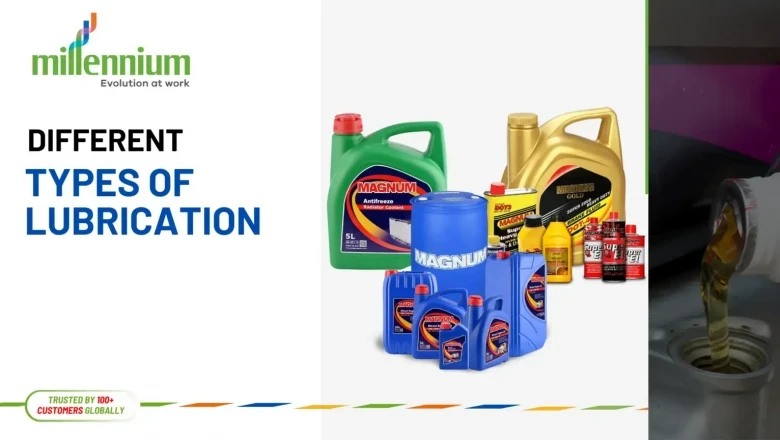views
Different Types of Lubrication
What Is Lubrication?
Lubrication is a fundamental process in the field of mechanics and engineering, aimed at reducing friction and wear between surfaces in relative motion. It involves the application of a lubricant, which is typically a fluid, solid, or semi-solid substance, to create a film that separates and smooths the interacting surfaces. This thin layer of lubricant minimizes direct metal-to-metal contact, thereby reducing resistance to motion and preventing damage.
The primary purpose of lubrication is to enhance the efficiency and longevity of machinery by minimizing energy loss and preventing premature equipment failure. Friction, an inherent force opposing motion, generates heat and leads to wear, which can compromise the integrity of machine components. By introducing a lubricant, these adverse effects are significantly diminished. The lubricant reduces heat generation by carrying away thermal energy and provides a protective barrier, preventing abrasion and corrosion.
Moreover, lubrication plays an essential role in maintaining cleanliness within machines, as it helps to flush out contaminants and debris. The effectiveness of lubrication depends on the type and properties of the lubricant chosen, including its viscosity, thermal stability, and compatibility with the materials involved. This process is vital in a wide range of applications, from simple household devices to complex industrial machinery, ensuring smooth operation and extending the lifespan of mechanical systems.
How Lubrication Reduces Friction And Wear
Lubrication plays a crucial role in reducing friction and wear between mechanical components, ensuring the smooth operation of machinery and extending its lifespan. When two surfaces move against each other, friction is generated, leading to wear and energy loss. Lubrication mitigates these issues by forming a protective film or layer between the surfaces, which minimizes direct contact. This lubricating film can either be a liquid, such as oil, or a semi-solid like grease, depending on the application and operating conditions.
The reduction of friction through lubrication leads to several beneficial outcomes. Firstly, it decreases the amount of heat produced by the friction, thereby reducing thermal expansion and potential distortions of the mechanical parts. Secondly, lubrication can help to prevent the welding or adhesion of surfaces that are in contact under high pressure, commonly known as galling. In addition, by reducing the direct contact between surfaces, lubrication minimizes wear, which is the gradual removal of material from the surfaces that can compromise the integrity of the equipment over time.
Major Types Of Lubrication
Lubrication plays a crucial role in minimizing friction and wear between surfaces in contact. Different types of lubrication systems are employed based on the specific requirements and operating conditions of machinery. The three major types of lubrication are hydrodynamic, boundary, and mixed lubrication. Hydrodynamic lubrication is characterized by the complete separation of surfaces by a continuous film of lubricant, usually in applications with high speed and load.
This type forms a thick layer that effectively reduces friction and prevents surfaces from making direct contact, thus minimizing wear. Boundary lubrication, on the other hand, occurs when the lubricant film is too thin to completely separate the surfaces. Instead, protective additives in the lubricant help reduce wear by forming a chemical layer on the surfaces. Common in low-speed or heavily loaded conditions, boundary lubrication is crucial where full film lubrication cannot be achieved.
Grease Vs. Oil Lubrication
Grease and oil are two primary forms of lubrication used to reduce wear and friction in machinery. Understanding the differences between them is key to selecting the right form for a specific application. Grease is essentially an oil that has been thickened with a soap or other thickening agent, which gives it a semi-solid consistency. This makes it particularly well-suited for applications where it is important to prevent oil runoff or leakage, as it stays in place and provides a barrier against contaminants such as water and debris.
Grease is commonly used in components like bearings, joints, and gears, where its properties help reduce the need for frequent reapplication. Conversely, oil is fluid, providing a thinner, more penetrating form of lubrication that effectively cools and cleans components while lubricating. It is ideal for high-speed applications where heat dissipation is crucial, such as engines and turbines. The choice between grease and oil depends on various factors including the operating environment, load, speed, and temperature.
Choosing The Right Lubrication For Your Machinery
Choosing the right lubrication for your machinery is a crucial step in ensuring optimal performance and longevity of your equipment. The importance of selecting an appropriate lubricant cannot be overstated, as it greatly influences the efficiency, reliability, and durability of machinery. When deciding on the best lubrication, consider factors such as the nature of the machinery, the operating environment, load, speed, and temperature conditions.
For instance, machinery operating in high-temperature environments may require lubricants with higher thermal stability, while equipment functioning in colder conditions might need lubricants that maintain viscosity at lower temperatures. Additionally, the speed and load of the machinery play a significant role; high-speed operations often benefit from lighter oil, whereas heavy loads may require thicker, more viscous lubricants. Compatibility with materials and potential chemical reactions should also be evaluated to prevent corrosion or degradation.
Maintaining Lubrication Systems
Maintaining lubrication systems is crucial for ensuring the longevity and efficiency of machinery. Regular maintenance not only minimizes friction and wear but also prevents unexpected equipment failures and costly downtime. To maintain these systems optimally, it is important to adopt a systematic approach. Start by monitoring the oil or grease levels in machinery, ensuring that they are always within the recommended range.
Low levels can lead to increased friction and wear, while over-lubrication can cause overheating and energy losses.
Routine inspection of the lubricant's condition is also essential. This involves checking for signs of contamination, such as the presence of metal particles, water, or other impurities, which can degrade the lubricant's performance and accelerate equipment wear. Using oil analysis as part of your monitoring routine can provide valuable insights into the lubricant's condition and the overall health of the machinery.






















Comments
0 comment